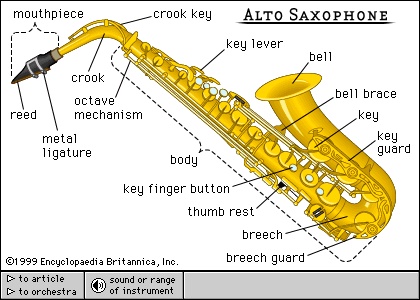saxophone
musical instrument
 any of a family of single-reed wind instruments (wind instrument) ranging from soprano to bass and characterized by a conical metal tube and finger keys. The first saxophone was patented by Antoine-Joseph Sax (Sax, Antoine-Joseph) in Paris in 1846.
any of a family of single-reed wind instruments (wind instrument) ranging from soprano to bass and characterized by a conical metal tube and finger keys. The first saxophone was patented by Antoine-Joseph Sax (Sax, Antoine-Joseph) in Paris in 1846.A saxophone has a conical metal (originally brass) tube with about 24 openings controlled by padded keys; the mouthpiece is similar to that of a clarinet. Two octave key vents allow the instrument to overblow to a higher register at the octave. Except for the sopranino and one form of the B♭ soprano saxophone, built straight like a clarinet, saxophones have an upturned lower end and a detachable crook, or neck, at the upper end.
The normal compass originally extended from B (B below middle C) to f‴ (the third F above middle C), but it soon was expanded downward one half step to include B♭. The compass of the most commonly used members of the saxophone family has been further increased: the alto and tenor can sound one half step above f‴, and the baritone can sound one half step below B♭. The compass is pitched differently for each member of the family: the B♭ soprano, a tone lower than written; the E♭ alto, a sixth lower; the B♭ tenor (made with an undulating crook), a ninth lower; the E♭ baritone (with a looped crook), an octave below the alto; and the B♭ bass (similar in shape to the baritone), an octave below the tenor. Rare forms, representing the extreme ranges of the instrument, include the sopranino, contrabass, and subcontrabass saxophones. All of the common forms were originally pitched in C or in F; the C melody saxophone, a tenor in C, is occasionally used for playing vocal music without transposition.
 Sax left no historical account of his invention, which was intended for both military bands and orchestras (orchestra) and which may have stemmed from experiments with reed mouthpieces on brass instruments (brass instrument). He quickly procured its official adoption by the French army, and it soon spread to other countries. The saxophone was a popular solo instrument in the United States about World War I and was subsequently adopted in dance bands, becoming one of the most important solo instruments in the development of swing and other forms of jazz. Its use in big bands brought changes in mouthpiece design to produce a brighter, more penetrating sound. Modern instruments are also wider in bore than early ones.
Sax left no historical account of his invention, which was intended for both military bands and orchestras (orchestra) and which may have stemmed from experiments with reed mouthpieces on brass instruments (brass instrument). He quickly procured its official adoption by the French army, and it soon spread to other countries. The saxophone was a popular solo instrument in the United States about World War I and was subsequently adopted in dance bands, becoming one of the most important solo instruments in the development of swing and other forms of jazz. Its use in big bands brought changes in mouthpiece design to produce a brighter, more penetrating sound. Modern instruments are also wider in bore than early ones.The saxophone has great flexibility, blending well with both brasses and woodwinds. It is not widely used as a concert instrument but is quite prominent in jazz, in which it is a principal vehicle for melodic improvisation. Among the greatest jazz saxophonists have been Lester Young (Young, Lester), Coleman Hawkins (Hawkins, Coleman), Charlie Parker (Parker, Charlie), Sonny Rollins (Rollins, Sonny), Ornette Coleman (Coleman, Ornette), and John Coltrane (Coltrane, John).
- Jacqueline-Marie-Angélique Arnauld
- Jacquerie
- Jacques-Alexandre-César Charles
- Jacques Amyot
- Jacques; and de Meuron Herzog, Pierre
- Jacques; and de Meuron, Pierre Herzog
- Jacques Audiberti
- Jacques-Auguste de Thou
- Jacques Bainville
- Jacques Barzun
- Jacques Bertillon
- Jacques Besson
- Jacques Bongars, Seigneur De Bauldry Et De La Chesnaye
- Jacques Borel
- Jacques Boucher de Perthes
- Jacques Brugnon
- Jacques-Bénigne Bossuet
- Jacques Callot
- Jacques Cartier
- Jacques Cartier, Mount
- Jacques Cassini
- Jacques Chaban-Delmas
- Jacques Champion de Chambonnières
- Jacques-Charles Brunet
- Jacques Chirac